
The spirotrichs are a large and diverse group of ciliate protozoa. They typically have prominent oral cilia in the form of a series of polykinetids, called the adoral zone of membranelles, beginning anterior to the oral cavity and running down to the left side of the mouth. There may also be one or two paroral membranes on its right side. The body cilia are fused to form polykinetids called cirri in some, and are sparse to absent in others.

Crinoids are marine invertebrates that make up the class Crinoidea. Crinoids that are attached to the sea bottom by a stalk in their juvenile form are commonly called sea lilies, while the unstalked forms, called feather stars or comatulids, are members of the largest crinoid order, Comatulida. Crinoids are echinoderms in the phylum Echinodermata, which also includes the starfish, brittle stars, sea urchins and sea cucumbers. They live in both shallow water and in depths as great as 9,000 meters (30,000 ft).
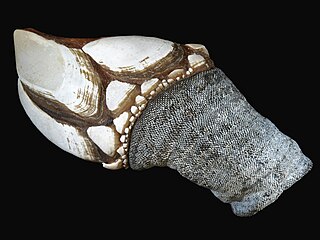
Goose barnacles, also called stalked barnacles or gooseneck barnacles, are filter-feeding crustaceans that live attached to hard surfaces of rocks and flotsam in the ocean intertidal zone. Goose barnacles formerly made up the taxonomic order Pedunculata, but the group has been found to be polyphyletic, with its members scattered across multiple orders of the infraclass Thoracica.

In invertebrates, the term parapodium refers to lateral outgrowths or protrusions from the body. Parapodia are predominantly found in annelids, where they are paired, unjointed lateral outgrowths that bear the chaetae. In several groups of sea snails and sea slugs, 'parapodium' refers to lateral fleshy protrusions.

Stylonychia is a genus of ciliates, in the subclass Hypotrichia. Species of Stylonychia are very common in fresh water and soil, and may be found on filamentous algae, surface films, and among particles of sediment. Like other Hypotrichs, Stylonychia has cilia grouped into membranelles alongside the mouth and cirri over the body. It is distinguished partly by long cirri at the posterior, usually a cluster of three. The largest can just be seen at a 25x magnification, and the smallest can just be seen at a 450x magnification.
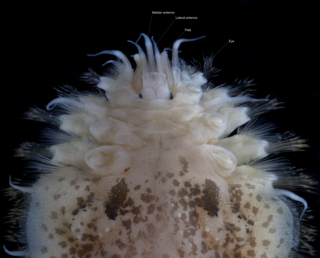
The prostomium is the cephalized first body segment in an annelid worm's body at the anterior end. It is in front of the mouth, being usually a small shelf- or lip-like extension over the dorsal side of the mouth. The prostomium together with the peristomium, which includes the mouth and pharynx, make up the annelid head.
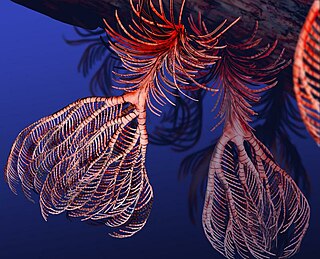
Pentacrinites is an extinct genus of crinoids that lived from the Hettangian to the Bathonian of Asia, Europe, North America, and New Zealand. Their stems are pentagonal to star-shaped in cross-section and are the most commonly preserved parts. Pentacrinites are commonly found in the Pentacrinites Bed of the Early Jurassic of Lyme Regis, Dorset, England. Pentacrinites can be recognized by the extensions all around the stem, which are long, unbranching, and of increasing length further down, the very small cup and 5 long freely branching arms.

Euplotes is a genus of ciliates in the subclass Euplotia. Species are widely distributed in marine and freshwater environments, as well as soil and moss. Most members of the genus are free-living, but two species have been recorded as commensal organisms in the digestive tracts of sea urchins.

Xeromphalina campanella is a species of mushroom. The common names of the species include the golden trumpet and the bell Omphalina. The genus name Xeromphalina means "little dry navel" and campanella means "bell-shaped", respectively describing the mature and young shapes of the pileus, or cap. The mushroom is also called fuzzy-foot.

Xeromphalina is a genus of fungi in the family Mycenaceae. The genus has a widespread distribution, and contains about 30 species.
Xeromphalina campanelloides is a species of Mycenaceae fungus. The fungus is known from coastal British Columbia and Washington, and eastern montane New York and Quebec. It was described as new to science in 1988 by Canadian mycologist Scott Redhead.
In biology, a cirrus is a long, thin structure in an animal similar to a tentacle but generally lacking the tentacle's strength, flexibility, thickness, and sensitivity.

Isocrinida is an order of sea lilies which contains four extant families.
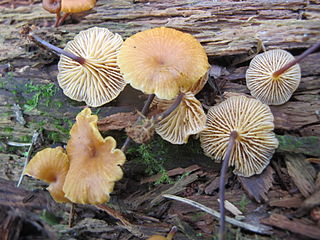
Xeromphalina cauticinalis is a species of agaric fungus in the family Mycenaceae. Originally described in 1838 by Elias Fries as Marasmius cauticinalis, it was transferred to the genus Xeromphalina by Robert Kühner and René Maire in 1934. It is found in North America, where it fruits in the summer and autumn singly or in groups on the seeds, needles, and sticks of conifers, and sometimes on aspen leaves. The fruit bodies have convex yellowish caps measuring 0.5–2.5 cm (0.2–1.0 in) in diameter supported by a tough yellow-brown to dark brown stipe that is 3–8 cm (1.2–3.1 in) long by 1–2.5 mm thick. The pale yellow gills have a decurrent attachment to the stipe and are somewhat distantly spaced. The spore print is white, while individual spores are elliptical, smooth, amyloid, and measure 4–7 by 2.5–3.5 μm.

Xeromphalina brunneola is a species of agaric fungus in the family Mycenaceae. Found in the western United States where it grows in dense clusters on debarked conifer logs, it was described by mycologist Orson K. Miller in 1968. The type collection was made by Miller near Priest River, Idaho, in September 1964. The mushroom has a dull orange, convex to nearly flattened cap measuring 0.6–15 mm (0.02–0.59 in) in diameter. The orange-buff gills are narrow, closely spaced, and decurrently attached to the stipe. Spores are elliptical, smooth, amyloid, and measure 5.5–6.6 by 2.5–3.0 μm.

Xeromphalina cornui is a species of agaric fungus in the family Mycenaceae. It was originally described in 1866 by French mycologist Lucien Quélet as Omphalia cornui; Swiss naturalist Jules Favre transferred it to Xeromphalina in 1936.
Xeromphalina junipericola is a species of agaric fungus in the family Mycenaceae. Found in Juniperus thurifera forests of Spain, it was described as new to science in 1996. The fruit bodies have purplish to violaceous tinged caps measuring 0.2–0.6 cm in diameter. It has smooth, amyloid, and hyaline (translucent) spores measuring 3–4 by 2–2.5 μm.
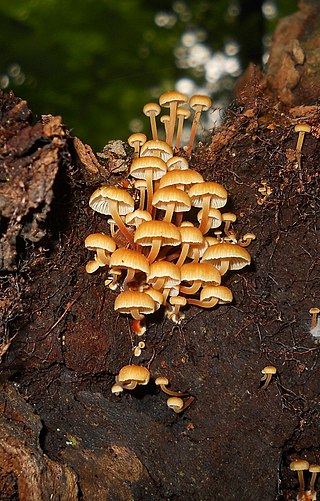
Xeromphalina kauffmanii is a species of agaric fungus in the family Mycenaceae. Found in North America, Costa Rica, and Japan, it was described as new to science in 1953. The type collection was made in Chelsea, Michigan, in June 1940. The specific epithet kauffmanii honors American mycologist Calvin Henry Kauffman.
Buccal cirri are feeding structures found in the oral hood of primitive jawless organisms called amphioxus. The word buccal is derived from the term bucca which means "cheek" and cirri is derived from the Latin word cerrus meaning a tendril or a small and flexible appendage.
Cirrí Sur is a district of the Naranjo canton, in the Alajuela province of Costa Rica.














